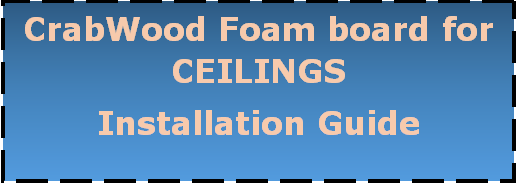Conditions of Use
Crabwood Foam boards are intended for normal conditions of dry internal use. All performance testing of CrabWood Foam boards has been carried out using dry ex-factory product. CrabWood Foam boards can be exposed to moisture or be installed in situations where extended exposures to humidity’s of 95% . The existing suitable surface finish can withstand wet areas where liquid water or high humidity can be expected. Acrylic emulsion, gloss and semi-gloss alkyd paints are suitable coating systems if desired. It would be preferred that Bathrooms, kitchens and laundries have adequate ventilation or heating to avoid condensation build up.
CrabWood Foam wall boards is a finishing material and must be fully protected on construction sites and during construction from direct or indirect damage, excessive sunlight or moisture.
Planning and Measuring
• Good planning of sheet layout is important.
This will reduce wastage and keep the number of joints to a minimum, saving
time and extra costs.
• On ceilings
the use of maximum sheet sizes minimises the occurrence of end butt joints.
Where end butt joints occur they must be formed, preferably, on framing members
where joints can be neatly finished.
• Sheets may be fixed either vertically or
horizontally and should ideally run right through and over electrical sockets
and ceiling light openings. The openings can then be cut out when sheets are in
place.
• The CrabWood foam sheets can be fitted near flush to door or window frame corners or on jamb studs but an 8-10 mm gap should be maintained to allow for timber frame movements as this is a point of stress.
Delivery, Handling & Storage
• Where possible CrabWood Foam Boards should
be delivered to site immediately or only a few days before installation as this
greatly reduces the possibility of damage.
• Sheets should be neatly stacked on their horizontal edge to avoid sheet distortion, damage. This can be achieved by stacking on a clean flat surface a minimum of 100 mm above ground level that is not susceptible to moisture. Do not stack directly on concrete floors
• Care should
be taken to prevent any undue sagging or damage to edges, ends or surfaces
during storage and handling.
• All materials should be kept dry, preferably
by being indoors above floor level and under cover (especially when storage is
likely to be for a lengthy period). While stored, foam boards should be
protected from moisture ( cover with plastic sheet or tarpaulin )
• CrabWood Foam Boards can be used on areas
exposed to moisture.
• It is preferred that either face of the sheets
not be placed in a horizontal position to prevent footprints and other marks or
damage to the face.
• Cracked or damaged sheets must not be used.
• Floor Loadings should be considered as
Meltin Vaste Foam boards can weigh in the range of 700–900 kg/m3.
Pre-Inspection of the Site Framework
• Check that the framing is plumb, level and
square and has been erected according to the relevant building specification.
The framing must have a minimum flat face width of 35mm for timber and 32mm for
steel.
• Plumbing and electrical services should be
installed before CrabWood Foam Board is fixed and all service ducting, pipes,
outlets and electrical connections should be set back from the framing and not
protrude beyond the face of the framing.
• Make sure
all contact surfaces of the framing are dry and free from dirt, grease, oil or
any other foreign material.
Note – The
fixing of CrabWood Foam boards is deemed to be an acceptance of the substrate,
so it is important to make sure that the above requirements are adhered to.
Framing
Spacing. The spacing of framing
support for CrabWood Foam Board shall not be greater than 600 mm centres for
all thicknesses of CrabWood Foam boards. The requirements for framing spacing
are detailed below.
• It is recommended that Framing centres be
kept at 450mm in Bathrooms or other areas that may be subject to moisture and
steam when using 10 mm CrabWood Foam
Board for ceilings. On ceilings we recommend the use of steel battens, as
timber battens can be subject to expansion and contraction.
Surface Joints and angled joints
A Versatile Medium Weight Filler
We would recommend ADOS Plastic putty to fill all all joints, scratches / screw holes and accidental dents using a spatula or scraper to achieve a smooth finish. Once you have filled the gaps embed the fibre tape and apply one more surface coat and allow to dry. Depending on the temperature and the humidity drying time can vary from 30 min to an hour . Once the surface is dry you can sand the surface smooth . Wipe the sanded surface with a dry cloth to remove all loose dust before you start painting. . The finish should be free of tool marks and ridges.
ADOS Plastic Putty is an all-purpose, versatile,
fast curing, medium weight polyester filler. It gives an extremely high quality
finish for general body filling on a variety of surfaces.
Please ensure
you apply the filler in 2-3 coats to ensure proper drying between coats.
Uses
Jointing tape
FibaFuse® is an innovative paperless
drywall joint tape designed for professional renovators and re modellers.
FibaFuse is a mold-resistant glass mat drywall tape that is ideal for use with
mold-resistant and paperless drywall systems for high-humidity and
moisture-prone applications.
Fiba Fuse is easy to cut and retains its folds, making it easy to install by hand on joints in corners.
GENERAL CEILING INSTALLATION
The following
section covers the installation of CrabWood Foam Boards in ceiling
applications.
Inspection of the Framing
• Flatness of Framing :
Inspect the
surface of the framing and ensure that it is flat. In particular take note of
nails not protruding over the surface, nogs not flush, hold down straps not
checked in flush to the surface etc.
• It is
important to ensure the framing is dry before fixing ceiling linings.
Cutting
CrabWood Foam Board
• CrabWood
Foam wall board is easily cut using conventional tools ( Saw ) or power tools.
• Cut-outs
for lighting fixtures and other penetrations should be marked before cutting commences.
CEILING INSTALLATION
Fixing to Ceilings using Adhesive/Screw
• Fix ceiling
sheets across battens or joists.
• Steel
battens are recommended.
• We
recommend 10mm sheets suitable for ceilings.
• Apply
adhesive to battens or joists at 200mm centres between centre and edge of
sheet.
• Start
fixing from the centre of each sheet outwards.
• Position the sheet hard up to the framing,
single screw at the centre line and the edges across each batten.
• Nailing is
not recommended.
• Single screws to be minimum 12mm from sheet edge. • Press the foam board where adhesive has been applied to ensure full contact.
• Sheet end
joints can be made on framing. If not ensure they are in level with each other.
• Adhesive
can be applied to the sheet edges or under screws.
• All joints
between sheets should be filled with ADOS plastic putty and allowed to dry.
• Use long
length sheets to minimise sheet end butt joints.
• The use of a drywall lifter will greatly
assist the builder in achieving optimum results.






